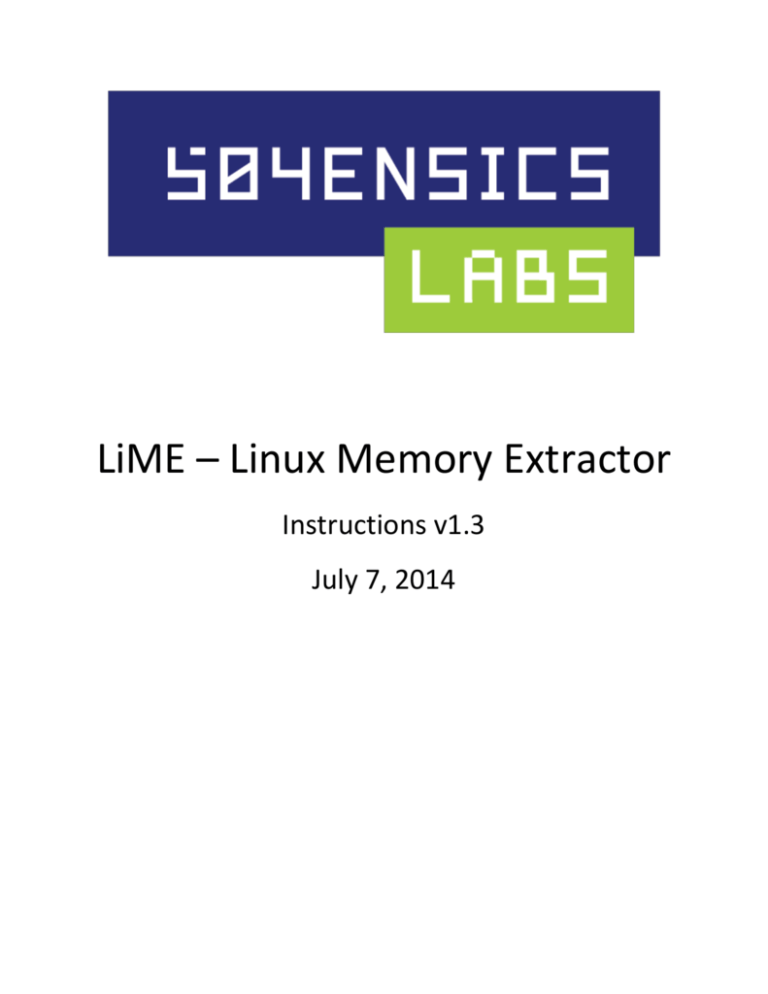LiME_Documentation_1.3
advertisement

LiME – Linux Memory Extractor
Instructions v1.3
July 7, 2014
Page |2
Contents
1.0
Introduction ...................................................................................................................................... 3
2.0
Obtaining LiME .................................................................................................................................. 3
3.0
Compiling LiME ................................................................................................................................. 4
3.1
Compiling LiME for Linux .............................................................................................................. 4
3.2
Compiling a Debug Version of LiME .............................................................................................. 4
3.3
Cross-Compiling LiME for Android ................................................................................................ 4
4.0
Using LiME......................................................................................................................................... 7
4.1
LiME Parameters ........................................................................................................................... 7
4.2
Acquisition of Memory over TCP .................................................................................................. 7
4.3
Acquisition of Memory to Disk (SD-Card) ..................................................................................... 8
5.0
LiME Memory Range Header Version 1 Specification ...................................................................... 9
3300 Canal Street, Suite 250, New Orleans, LA 70119 | (504) 210-5870 | www.504ensics.com
Page |3
1.0 Introduction
LiME (formerly DMD) is a Loadable Kernel Module (LKM)that allows the acquisition of volatile
memory from Linux and Linux-based devices, such as those powered by Android. The tool
supports acquiring memory either to the file system of the device or over the network. LiME is
unique in that it is the first tool that allows full memory captures from Android devices. It also
minimizes its interaction between user and kernel space processes during acquisition, which
allows it to produce memory dumps that are more forensically sound than those of other tools
designed for Linux memory acquisition.
LiME was first announced at ShmooCon 2012. The video of the presentation can be found
here, and the slides are available for download here.
2.0 Obtaining LiME
To obtain LiME, please see the instructions at: http://code.google.com/p/lime-forensics.
3300 Canal Street, Suite 250, New Orleans, LA 70119 | (504) 210-5870 | www.504ensics.com
Page |4
3.0 Compiling LiME
3.1 Compiling LiME for Linux
LiME is a Loadable Kernel Module (LKM). LiME ships with a default Makefile that should be
suitable for compilation on most modern Linux systems.
For detailed instructions on using LKM see the file Documentation/kbuild/modules.txt included
with the Linux kernel source.
3.2 Compiling a Debug Version of LiME
When compiling LiME with the default Makefile, using the command “make debug” will compile a LiME
module with extra debug output. The output can be read by using the dmesg command on Linux.
3.3 Cross-Compiling LiME for Android
In order to cross-compile LiME for use on an Android device, additional steps are required.
PREREQUISITES
Disclaimer: This list may be incomplete. Please let us know if we've missed anything.
Install the general android prerequisites found here.
Download and un(zip|tar) the android NDK found here.
Download and un(zip|tar) the android SDK found here.
Download and untar the kernel source for your device. This can usually be found on the
website of your device manufacturer or by a quick Google search.
Root your device. In order to run custom kernel modules, you must have a rooted
device.
Plug the device into computer via a USB cable.
3300 Canal Street, Suite 250, New Orleans, LA 70119 | (504) 210-5870 | www.504ensics.com
Page |5
SETTING UP THE ENVIORNMENT
In order to simplify the process, we will first set some environment variables. In a terminal,
type the following commands.
$ export SDK_PATH=/path/to/android-sdk-linux/
$ export NDK_PATH=/path/to/android-ndk/
$ export KSRC_PATH=/path/to/kernel-source/
$ export CC_PATH=$NDK_PATH/toolchains/arm-linux-androideabi4.4.3/prebuilt/linux-x86/bin/
$ export LIME_SRC=/path/to/lime/src
PREPARING THE KERNEL SOURCE
We must retrieve and copy the kernel config from our device.
$
$
$
$
cd $SDK_PATH/platform-tools
./adb pull /proc/config.gz
gunzip ./config.gz
cp config $KSRC_PATH/.config
Next we have to prepare our kernel source for our module.
$ cd $KSRC_PATH
$ make ARCH=arm CROSS_COMPILE=$CC_PATH/arm-eabi- modules_prepare
PREPARING THE MODULE FOR COMPILATION
We need to create a Makefile to cross-compile our kernel module. A sample Makefile for crosscompiling is shipped with the LiME source. The contents of your Makefile should be similar to
the following:
obj-m := lime.o
lime-objs := main.o tcp.o disk.o
KDIR := /path/to/kernel-source
PWD := $(shell pwd)
CCPATH := /path/to/android-ndk/toolchains/arm-linux-androideabi4.4.3/prebuilt/linux-x86/bin/
default:
$(MAKE) ARCH=arm CROSS_COMPILE=$(CCPATH)/arm-eabi- -C $(KDIR)
M=$(PWD) modules
3300 Canal Street, Suite 250, New Orleans, LA 70119 | (504) 210-5870 | www.504ensics.com
Page |6
COMPILING THE MODULE
$ cd $LIME_SRC
$ make
3300 Canal Street, Suite 250, New Orleans, LA 70119 | (504) 210-5870 | www.504ensics.com
Page |7
4.0 Using LiME
To illustrate the use of LiME, we will now walk through two examples of acquiring memory
from an Android device. We will first discuss the acquisition of memory over a TCP connection,
followed by a discussion of acquiring a memory dump via the device’s SD card. The use of LiME
on other Linux devices is similar; however, the use of the Android debug bridge (adb) is not
needed.
4.1 LiME Parameters
Starting in version 1.1, LiME now supports multiple output formats, including a custom lime
format which integrates with Volatility’s new lime address space. This means that additional
parameters are needed when installing the LiME kernel module.
NOTE: There is a bug in the insmod utility on some Android devices. Multiple kernel module
parameters must be wrapped in quotation marks, otherwise only the first parameter will be
parsed. See sections 4.2 and 4.3 for examples.
LiME Parameters
•
•
•
path
– Either a filename to write on the local system (SD Card) or tcp:<port>
format
– raw
• Simply concatenates all System RAM ranges
– padded
• Pads all non-System RAM ranges with 0s, starting from physical address 0
– lime
• Each range is prepended with a fixed-sized header which contains
address space information
• Volatility address space developed to support this format
dio (optional)
– 1 to enable Direct IO attempt (default), 0 to disable
4.2 Acquisition of Memory over TCP
The first step of the process is to copy the kernel module to the device’s SD card using the
Android Debug Bridge (adb), which supports a number of interactions with an Android device
tethered via USB. We then use adb to setup a port-forwarding tunnel from a TCP port on the
device to a TCP port on the local host. The use of adb for network transfer eliminates the need
3300 Canal Street, Suite 250, New Orleans, LA 70119 | (504) 210-5870 | www.504ensics.com
Page |8
to modify the networking configuration on the device or introduce a wireless peer—all network
data is transferred via USB. For the example below, we have chosen TCP port 4444. We then
obtain a root shell on the device by using adb and su. To accomplish this, we run the following
commands with the phone plugged into our computer and debugging enabled on the device.
$
$
$
$
#
adb push lime.ko /sdcard/lime.ko
adb forward tcp:4444 tcp:4444
adb shell
su
Memory acquisition over the TCP tunnel is then a two-part process. First, the target device
must listen on a specified TCP port and then we must connect to the device from the host
computer. When the socket is connected, the kernel module will automatically send the
acquired RAM image to the host device.
In the adb root shell, we install our kernel module using the insmod command. To instruct the
module to dump memory via TCP, we set the path parameter to “tcp”, followed by a colon and
then the port number that adb is forwarding. On our host computer, we connect to this port
with netcat and redirect output to a file. We also select the “lime” formatting option. When
the acquisition process is complete, LiME will terminate the TCP connection.
The following command loads the kernel module via adb on the target Android device:
# insmod /sdcard/lime.ko “path=tcp:4444 format=lime”
On the host, the following command captures the memory dump via TCP port 444 to the file
“ram.lime”:
$ nc localhost 4444 > ram.lime
4.3 Acquisition of Memory to Disk (SD-Card)
In some cases, such as when the investigator wants to make sure no network buffers are
overwritten, disk-based acquisition may be preferred to network acquisition. To accommodate
this situation, LiME provides the option to write memory images to the device’s file system. On
Android, the logical place to write is the device’s SD card.
Since the SD card could potentially contain other relevant evidence to the case, the investigator
may wish to image the SD card first in order to save unallocated space. Unfortunately, some
Android phones, such as the HTC EVO 4G and the Droid series, place the removable SD card to
3300 Canal Street, Suite 250, New Orleans, LA 70119 | (504) 210-5870 | www.504ensics.com
Page |9
be either under or obstructed by the phone’s battery, making it impossible to remove the SD
card without powering off the phone (these phones will power down if the battery is removed,
even if they are plugged into a power source!). For this reason, the investigator needs to first
image the SD card, and then subsequently write the memory image to it. While this process
violates the typical “order of volatility” rule of thumb in forensic acquisition, namely, obtaining
the most volatile information first, it is necessary to properly preserve all evidence.
Fortunately, imaging the SD card on an Android device that will be subjected to live forensic
analysis (including memory dumping) does not require removal of the SD card. Tethering the
device to a Linux machine, for example, and activating USB Storage exposes a /dev/sd? device
that can be imaged using traditional means (e.g., using dd on the Linux box). Activating USB
Storage mode unmounts the SD card on the Android device, so a forensically valid image can be
obtained.
With USB Storage mode deactivated, we copy the LiME kernel module to the device using the
same steps described in the last section. When installing the module using insmod, we set the
path parameter to /sdcard/ram.lime to specify the file in which to write the memory dump.
We also select the “lime” format option:
# insmod /sdcard/lime.ko “path=/sdcard/ram.lime format=lime”
Once the acquisition process is complete, we can power down the phone, remove the SD card
from the phone, and transfer the memory dump to the examination machine. If the phone
cannot be powered down, adb can also be used to transfer the memory dump to the
investigator's machine.
5.0 LiME Memory Range Header Version 1 Specification
typedef struct {
unsigned int magic;
// Always 0x4C694D45 (LiME)
unsigned int version;
// Header version number
unsigned long long s_addr;
// Starting address of physical RAM range
unsigned long long e_addr;
// Ending address of physical RAM range
unsigned char reserved[8];
// Currently all zeros
} __attribute__ ((__packed__)) lime_mem_range_header;
3300 Canal Street, Suite 250, New Orleans, LA 70119 | (504) 210-5870 | www.504ensics.com








